|
Biography |
DonNTU |
Theme of abstract :
"Parallel MIMD-solver of equations for a network dynamic object with distributed parameters"
Author: A.B. Guseva
Introduction
1. Network dynamic object with the distributed parameters as object of simulation.
2. Parallel block numerical method.
3. Sequential algorithm of one branch MVS computing by the block numerical method.
3.1. Leading of experiments and conclusions.
4. The approach to paralleling of solver for NDO.
The conclusion
Literature
Introduction
Progress of modern areas of technics, technologies and biotechnologies, environmental technologies
depends on the level of theory and practical realization of
design methods for automated technical objects, process installations and
lines which are defined as complex dynamic objects (CDO) [3]. One of the main stages in
CDO modeling is the development of equations solver.
Today there is a multitude of both parallel and sequential solver libraries, based on various numerical methods. Some of them are listed below:
- CVODE is a solver for systems of ordinary differential equations. CVODE contains methods for the solution of both stiff and non-stiff initial value problems. Uses Adams-Moulton, Krylov method and others. PVODE is a parallel version of CVODE.
- KINSOL has been developed for the solution of nonlinear algebraic equation systems. It uses an inexact Newton method.
- and others.
The problem of solvers development for network dynamic object (NDO) is as follows: for the system formed by the equations generator as it is demanded by tools of simulation and conformed to the description of NDO topology, to develop algorithms and the programs of the decision, that is based on consecutive and parallel numerical methods.
The purpose of work to develop consecutive and parallel implementation of equations solver, using a parallel block numerical method.
Among of series problems which were laid down for achievement of the aims, it is possible to emphasize the following:
Network dynamic object with the distributed parameters as object of simulation
Network objects are used in many areas of technics. Examples of such objects can be electric networks, oil pipelines, etc. Object of the research is the mine ventilating network (MVN) [2].
Network objects concern to complex dynamic systems through greater dimension, nonlinearity of characteristics and they are distributed concerning spatial coordinates parameters.
All dynamic systems can be parted into two classes:
- systems with the concentrated parameters;
- systems with the distributed parameters.
Systems with the concentrated parameters are described by means of finite number of the algebraic and ordinary differential equations that are depended on time variables. Systems with the distributed parameters are described by means of the partial differential equations. Here the condition variable during each moment of time is a function of one or several coordinates of space. In the further it will be considered a transitive aerodynamic processes in MVN which elements are considered as objects with the distributed parameters.
The topology of network object is represented in the form of the graph. Each network object depends on external limiting conditions. To this conditions concern the pressure in an initial node, which is connected with an atmosphere, and pressure in nodes to which the creating constant pressure fans are connected.
If it will be considered a separate branch with an index i, then processes of an air flow
Qi and pressure Pi changing are represented in the form of the
following equations [2]:
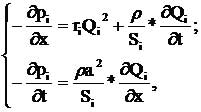
where Pi– value of pressure in ³-th branch;
ri – specific aerodynamic resistance;
à – speed of a sound in air;
Si – the area of a branch section;
õ – coordinate along a branch.
After approximation of these equations by a method of straight lines [1] it is derived following equations systems for j-th element of a branch:
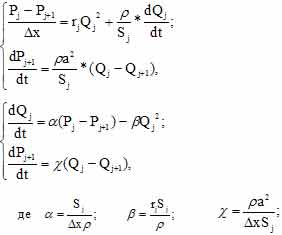
For MVS simulation it is necessary to choose of a numerical method. There is known following numerical methods:
- Euler method;
- Adams-Bashfort method;
- Runge-Kutta method;
- block methods.
The first three numerical methods have one general feature. They are based on sequation computing algorithms. Last method gives an opportunity for finding of several value of pressure air flow, that is actual for the solution of such complex problem with great computing volume and can reduce the duration of computing.
Parallel block numerical method
Parallel block numerical methods solve Cauchy problem. Cauchy problem has a following appearance for one ordinary differential equation of the first order [1]:

Parallel block numerical methods of the Cauchy problem decision is divisible by single-step and multistage methods. On figure 1 it is shown the scheme of a single-step k-point method on N blocks splitting.

Figure 1
New k values are calculated simultaneously for each following block during the numerical solution of Cauchy problem . On figure 2 the pattern of single-step k-point finite-difference schemes is presented.
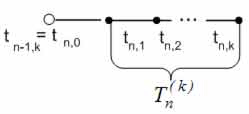
Figure 2
The formula for calculation new k values is following:


For the solution of factors ai,j and bi
it is necessary to construct construct Lagrange interpolating polynomial Lk(t)
with nodes of interpolation tn , i, i = 0,1,…,k and values
Fn,i = f(tn, i, un, i)
corresponding them, and to integrate in boundary (tn, tn + i*  ) .
Values in each point of the n-block for a two-point block method are necessary to calculate under following formulas:
) .
Values in each point of the n-block for a two-point block method are necessary to calculate under following formulas:

Sequential algorithm of one branch MVS computing by the block numerical method
On figure 3 it is resulted the general Sequential algorithm of one branch MVS computing by the parallel block single-step two-point method for one block.
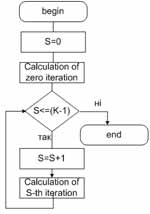
Figure 3
It was leaded a number of modeling experiments. The purpose of them was establishment of sequential implementation working of a block single-step
two-point method and comparison it with the sequential program that realized the Adams-Bashfort
method. Object of simulation is benchmark mine working with
following aerodynamic parameters: length of one branch L = 2000 m, the
area of section of branch S=7 m2,
specific aerodynamic resistance rsr = 0.00048 Ns2/m9.
Other characteristics are:
M - quantity of elements in length  ,
into which one mine branch is divided;
,
into which one mine branch is divided;  –
a time step of the equations approximation by numerical method.
–
a time step of the equations approximation by numerical method.
By results of the experiments it is possible to become following conclusions:
The increase or reduction of equations approximation time step
 leads to change of processes Q1(t) and QM(t)
character when the value of M nodes number in one branch is fixed and Ð (t) is jumping. Efficiency and speed of technological
process passing depend on accuracy of a time
step
leads to change of processes Q1(t) and QM(t)
character when the value of M nodes number in one branch is fixed and Ð (t) is jumping. Efficiency and speed of technological
process passing depend on accuracy of a time
step  equations approximation choice. Otherwise processes Q (t) can go in overrun.
equations approximation choice. Otherwise processes Q (t) can go in overrun.
The Increase of node number M in one branch leads to increase of technological process time duration.
Realization of a task by a block numerical method, in comparison with the Adams-Bashfort method, gives a greater gain in time (approximately by a factor of two).
The approach to paralleling of solver for NDO
In figure 4 it is shown four possible levels of paralleling. Data exchange between processes is carried out by means
of MPI (Message Passing Interface) [5].
At the lowest level each process is engaged in the decision of
only one equation. At the second level process calculate a separate part of a branch.
Each branch or node is calculated at the
third level. And at last level NDO graph divide into separate parts.
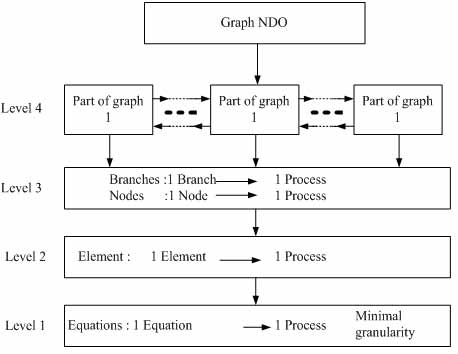
Figure 4
The conclusion
In work it has been developed sequential implementation of a block single-step
two-point method, has been lead a number of experiments for its comparison with the consecutive Adams-Bashfort method.
It was developed a parallel implementations of MVO for one branch at first two paralleling levels
by a block method.
Further it is planned to research two last paralleling levels of all
simulated object and leaded a number
of experiments, that will be concerned to efficiency and ways of a block numerical method paralleling.
Literature
[1] L.P. Feldman, A.I. Petrenko, O.A. Dmitrieva.
"Numeric methods in informatics", 2006.
[2] F.A.Abrmov, L.P. Feldman, V.A. Svyatniy.
"Dynamics processes simulation of mine aerology", 1981
[3] V.A. Svyatniy., O.V. Moldovanova, L.O. Pererva.
"Problem-oriented parallel sumulation environment for dynamics network objects", 2001.
[4] MPI 2.0 Standart www.mpi-forum.org/docs


